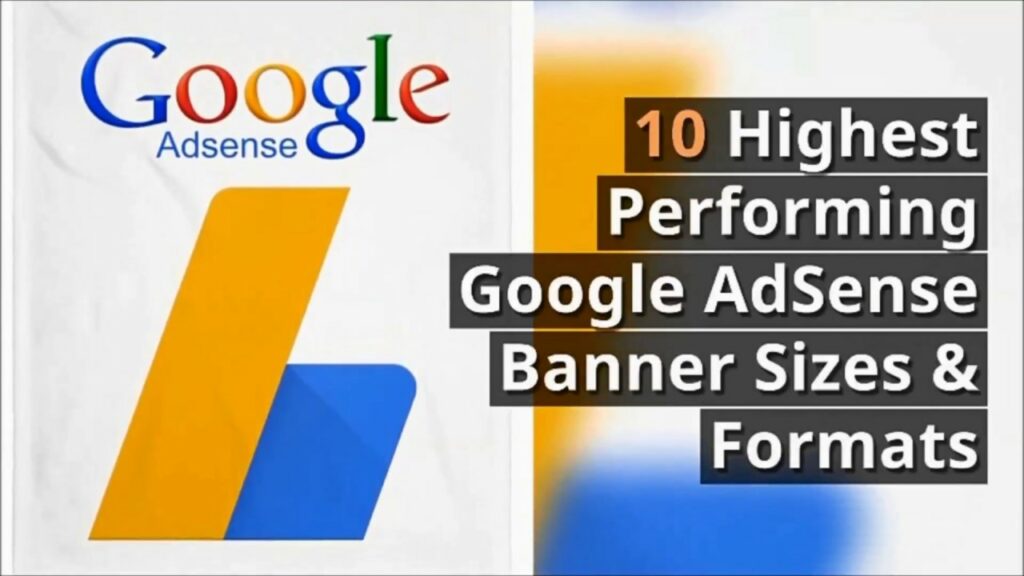
1. Understanding the Importance of Google AdSense Banner Sizes
🔍Understanding the Importance of Google AdSense Banner Sizes🔍
When it comes to maximizing the revenue potential of your website, Google AdSense is a powerful tool that can help you achieve your goals. However, one of the key factors that often gets overlooked is the importance of selecting the right banner size for your ads. In this article, we’ll dive into why understanding and optimizing your Google AdSense banner sizes is crucial for your website’s success.
📐Choosing the right banner size is essential for a number of reasons. First and foremost, it directly impacts the user experience on your site. By selecting an appropriately sized banner, you can ensure that it fits seamlessly within your website’s design while not compromising the overall aesthetics. A banner that is too big or too small can disrupt the flow of your content and hinder user engagement.
💰Additionally, the size of the Google AdSense banner can greatly affect your ad performance and revenue generation. Various studies and data have shown that certain banner sizes tend to perform better in terms of click-through rates (CTR) and overall ad visibility. By strategically selecting the right size based on your website’s layout and traffic patterns, you can increase the chances of users interacting with your ads and boosting your earnings.
🎯Moreover, it’s important to consider the specific ad formats supported by Google AdSense and the corresponding banner sizes that work best for each format. Whether it’s a traditional leaderboard, a skyscraper ad, or an in-page display, understanding which banner sizes are optimized for each format can greatly enhance your ad placements and overall monetization strategy.
By fully understanding the importance of Google AdSense banner sizes, you can make informed decisions that not only enhance the user experience on your website but also maximize your ad performance and revenue potential. Remember, size matters when it comes to digital advertising, and selecting the right banner size can play a crucial role in achieving your website’s monetization goals. Stay tuned for upcoming articles where we’ll explore the best practices for optimizing banner sizes for different devices and platforms. 🌟
2. Top Recommended Google AdSense Banner Sizes
🖥️
In the world of online advertising, Google AdSense is a popular and effective tool for website owners to monetize their content. One important factor to consider when using AdSense is the choice of banner sizes. The right size can make a significant difference in the performance and revenue generated by your ads. In this article, we will explore the top recommended Google AdSense banner sizes.
💡
When it comes to banner sizes, there are several options available. However, based on industry standards and user engagement, certain sizes tend to perform better than others. The top recommended banner sizes for Google AdSense are 300×250, 336×280, 728×90, 160×600, and 320×100 pixels.
📈
The 300×250 ad unit, also known as the medium rectangle, is one of the most popular sizes. It fits well within content and is highly versatile. Similarly, the 336×280 ad unit, commonly referred to as the large rectangle, tends to have higher click-through rates due to its prominent placement.
💰
Another popular option is the 728×90 leaderboard. This horizontal banner size is often placed at the top or bottom of webpages, making it highly visible to users. Additionally, the 160×600 wide skyscraper and the 320×100 large mobile banner are both effective choices for mobile advertising.
👀
Choosing the right Google AdSense banner size is crucial for optimizing your ad revenue. By selecting one of the top recommended sizes, you increase the chances of attracting user attention, generating clicks, and ultimately earning more money from your website. Experiment with different sizes to find the best fit for your content and audience.
📊
In conclusion, when it comes to Google AdSense banner sizes, it’s essential to prioritize user experience and engagement. The top recommended sizes, such as the 300×250, 336×280, 728×90, 160×600, and 320×100, offer a balance between visibility and effectiveness. Consider the layout of your website, the demographics of your audience, and the type of content you offer when choosing the right size for your Google AdSense banners.
- 📱👨⚕️ Descubre cómo optimizar tu experiencia de atención médica con el Banner Patient Portal
- 🎨 ¡Descubre el impresionante mundo del 🌸 Banner Fu Xuan! ¡Inspírate con diseños increíbles y colores vibrantes! 🖼️💫
- 🎉 ¡Revive la nostalgia con el mejor 🔥 banner de los 80! Descubre los diseños más icónicos y tendencias de la época
- 🎉🌍 ¡Descubre los mejores ✈️ banners para tus viajes! Atrae miradas y planifica tus aventuras con estilo 🌟
- 🎯 ¡Descubre el poder del sensor manual Banner Q4X en español! 🌐
3. How to Choose the Right Banner Size for Your Website
🖼️
Choosing the right banner size for your website is crucial for creating a visually appealing and user-friendly interface. A well-designed banner can enhance your website’s overall look and feel, while an inappropriate size can lead to a cluttered and unprofessional appearance. In this article, we will explore the key factors to consider when selecting the perfect banner size for your website.
First and foremost, you need to determine the purpose and placement of your banner. Is it intended to be the main focal point of your website or just a supporting element? Once you have a clear understanding of its purpose, you can move on to selecting the appropriate dimensions.
Consider the layout and responsive design of your website. A responsive banner size ensures that it adapts seamlessly across different devices and screen sizes. With the increasing use of mobile devices, it’s essential to choose a size that looks equally good on desktops, tablets, and smartphones.
Another critical aspect to consider is the content you plan to display on the banner. If you want to showcase a single powerful image, a larger size might be suitable. On the other hand, if you intend to include multiple visuals or text elements, a smaller banner size may work better, as it won’t overwhelm the user with too much information.
Moreover, it’s essential to think about the loading time of your website. Larger banners with high-resolution images can significantly impact the loading speed, resulting in a poor user experience. Opt for an optimal banner size that ensures fast loading times without compromising on visual quality.
In conclusion, choosing the right banner size for your website is integral to its overall design and functionality. Consider factors such as purpose, layout, responsiveness, content, and loading times when making your decision. By selecting an appropriate size, you can captivate your audience, convey your message effectively, and create a visually impressive website.
4. Common Mistakes to Avoid When Selecting Banner Sizes
📢 Common Mistakes to Avoid When Selecting Banner Sizes 📢
When it comes to online advertising, selecting the right banner size is crucial for capturing the attention of your target audience. However, many marketers often make common mistakes that can negatively impact the effectiveness of their campaigns. In this article, we will uncover the four most common mistakes to avoid when selecting banner sizes, ensuring that your ads stand out and drive maximum engagement.
🚫 Mistake #1: Using One Size Fits All Approach 🚫
One of the biggest mistakes marketers make is using a one-size-fits-all approach when selecting banner sizes. Each platform and placement has its own requirements, so it’s important to tailor your ad sizes accordingly. Ignoring this can result in distorted or cropped banners that fail to convey your message effectively. Take the time to research and understand the specifications for different platforms to optimize your banner sizes for maximum impact.
🚫 Mistake #2: Ignoring Mobile Optimization 🚫
With the increasing use of smartphones, neglecting mobile optimization can be detrimental to your digital advertising efforts. Many marketers overlook the fact that people consume content on their mobile devices more than ever before. Failing to adapt your banner sizes for mobile can lead to poor user experience and lost opportunities. Ensure your banner sizes are responsive and mobile-friendly to effectively reach your target audience wherever they are.
🚫 Mistake #3: Neglecting Testing and Analytics 🚫
Another common mistake is neglecting to test different banner sizes and analyze the data to make informed decisions. Your target audience’s preferences and behavior may vary across platforms and devices. By testing multiple banner sizes and analyzing the performance metrics, you can optimize your campaigns and select the sizes that drive the highest click-through rates, conversions, and engagement.
🚫 Mistake #4: Overcrowding with Excessive Information 🚫
Lastly, overcrowding banners with excessive information is a surefire way to turn off your audience. Remember that banners are meant to capture attention and convey a clear message quickly. Including too much text or cluttering the design can overwhelm the viewer and decrease the chances of them taking action. Keep your banners visually appealing and concise, focusing on a single, compelling message.
By avoiding these common mistakes in selecting banner sizes, you can enhance the effectiveness of your digital advertising campaigns. Remember to customize banner sizes for different platforms, prioritize mobile optimization, test and analyze performance, and keep your designs clean and concise. With these tips in mind, you’ll be well on your way to creating impactful banners that drive results! 💪🎯
5. Testing and Optimizing Your AdSense Banner Sizes
🔍 SEO Content for H2: «5. Testing and Optimizing Your AdSense Banner Sizes» 🔍
In today’s blog post, we will dive into the importance of testing and optimizing your AdSense banner sizes.⭐️
⭐️ It is crucial for any website owner to find the perfect balance between ad visibility and user experience. By conducting tests and optimizing your AdSense banner sizes, you can maximize your revenue potential and provide a seamless browsing experience for your visitors.
⭐️ One effective method is A/B testing, where you compare different banner sizes to see which ones generate the most clicks and conversions. By experimenting with various sizes, you can identify the optimal AdSense banner dimensions that drive the highest engagement and revenue for your website.
⭐️ Remember, each website is unique, and what works for one may not work for another. Testing and optimizing your AdSense banner sizes allows you to tailor your ad strategy to suit the specific needs and preferences of your audience, ensuring that you are effectively monetizing your website without compromising user experience.
✅ Stay tuned for the next section, where we will explore some practical tips and best practices for testing and optimizing AdSense banner sizes. Don’t miss out on the opportunity to enhance your ad performance and boost your website’s revenue potential!💪🚀
